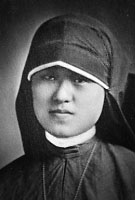
Sister Agneta Chang, MM
Born: Sept. 25, 1906
Entered: May 23, 1922
Death: Last seen – October 4, 1950
Sister Mary Agneta Chang came from a Korean family which had been Catholic from the time of persecution in the 19th century and included at least one martyr among her mother’s ancestors. Her father spoke Korean, Japanese and English fluently and provided education in the United States for two of his daughters as well as his sons. He was a friend of the Maryknoll Fathers from their foundation in Korea in 1923, as well as the Maryknoll Sisters. Her brother, John Chang, served as delegate to the United Nations, ambassador to the United States for the Republic of Korea (RIJK), and as Vice-President and Prime Minister of the Republic of Korea for brief terms.
Sister Agneta was assigned to Korea in 1925, after completing novitiate training at Maryknoll, NY. She did parish and catechical work in Uyju and taught Korean language to her Maryknoll Sisters. She had natural gifts for art and music, sewing and embroidery, and became proficient in English. She was attracted to the Scriptures and contemplative Saints and authors. After five years in Uyju, she went to Japan to the College of the Religious of the Sacred Heart for further study, obtaining a A.B. degree in 1935.
The Korean community of the Sisters of Our Lady of Perpetual Help (OLPHS) was started in the Maryknoll Diocese of Pyong Yang in 1931. Four Maryknoll Sisters were involved in the formation of this group and Sister Agneta joined them on completion of her studies. Sister Agneta remained with this community until her death.
Early in the 20th century, Japan had annexed Korea. After the outbreak of war between Japan and the United States in 1941, the American Sisters were repatriated. Sister Agneta was left alone to continue the work as novice mistress to the young community. During these years she found herself cut off from Maryknoll and in charge of 29 women with insufficient funds in a time of food shortages and high inflation. For a short time between the surrender of the Japanese to the Americans in Seoul in 1945 and late 1948 she again had contact with Maryknoll, receiving letters and supplies through her family in Seoul.
Russian troups had entered northern Korea before the end of World War II, accompanied by an army of Korean Communists. When the Russians pulled out in 1948, the Communists remained in control. The Sisters, middle-class and educated, attracted their enmity and experienced their more intensive use of investigations, inspections and residence checks. Sister Agneta, because of her American ties and her brother John’s position as diplomat, merited special suspicion. Sister Agneta did not risk appearing in public.
On May 14, 1950, the last building used by the Perpetual Help Sisters was taken over by the government, and each Sister, dressed in lay clothes, left for home. Sister Agneta’s health was poor, she had previous back surgery. Sister Peter Kang, OLPHS. accompanied her as she took refuge in various villages, the last being Songrimri, about 25 miles from Pyong Yang. On June 25, it is alleged that the DPRK invaded the ROK with initial success. By October, the United Nations forces began to drive northward, reaching the 38th parallel. On October 4, 1950, a representative of the Communist military mobilization office came for Sister Agneta, demanding that she help care for wounded soldiers. Sister Peter pleaded in vain that Sister Agneta was ill and unable to walk. Neighbors were forced to help load her bed on a waiting ox cart. Sister Peter tried to follow, but was turned away. Sister Agneta’s final moments remain unknown, but a group of women were said to have been executed and hastily buried in a mass grave. The site was never located.
